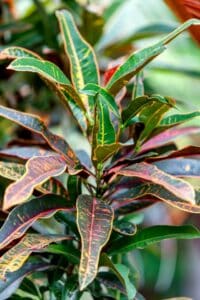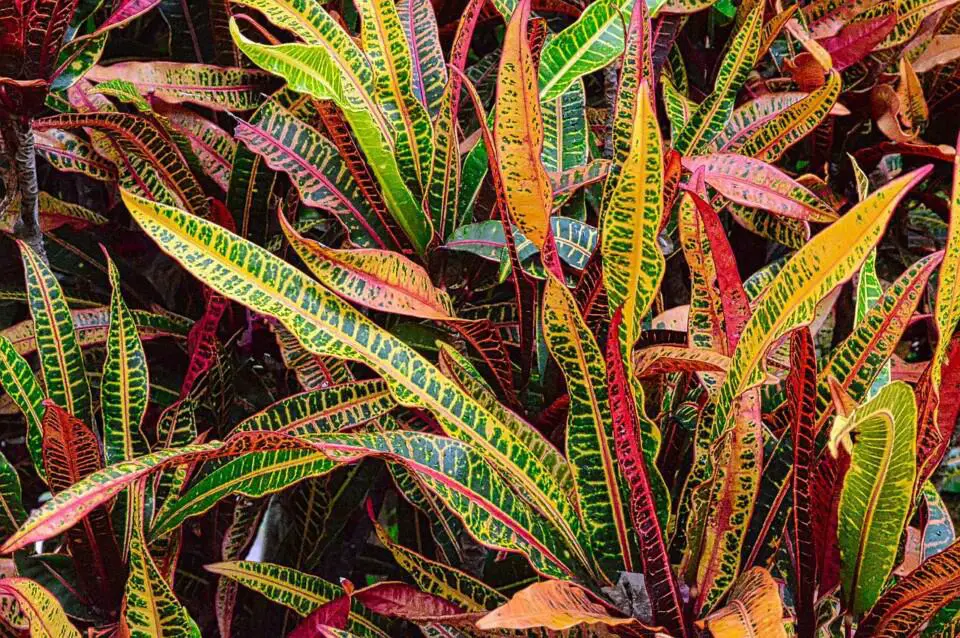Some links in the post are affiliate links and I get a commission from purchases made through some links found in the post.
You may also know this plant as the Garden Croton. Indeed, it is very popular because of the exotic appearance, and it is mostly used as an indoor plant now, where it is very successful due to the bright foliage.
Now, Crotons are often perceived to be high maintenance plants because they can be fussy about their ideal conditions. For this reason, many people may avoid having them as house plants.
The truth about the Croton is that once you understand the conditions it requires, they are normally easy to grow and low maintenance.
A fun fact about the Croton is that many years ago they were used in the medicine making industry. They were among the ingredients listed for emptying and cleaning the stomach, also used to treat colic, gallbladder issues and even malaria.
The seeds, however, are classed as unsafe and should never be ingested particularly by pregnant ladies.
The problem with Crotons is that to keep the leaves looking their best, they require special conditions, and this is what puts people off having these beautiful plants in the house.
In the perfect conditions the Croton will show leaves which are vibrant and striking, in hues of cream, orange, red, pink, purple, yellow, white, black, and even green.
To keep the Croton looking its best it needs to have the correct amount of humidity and sunlight.
The ideal humidity for a croton is between 40% to 80% and does best with temperatures between 60F to 70F. A croton likes to be misted. An ideal place to keep your croton is in the kitchen or the bathroom.
Fortunately providing the perfect environment for the Croton is not a difficult task, and once you know what it likes – and what it does not like – you will have a happy plant which will be the envy of your visitors.
What is the Ideal Humidity for a Croton?
 The perfect humidity range for a Croton is between 40% and 80%. The Croton needs warm weather and does best at temperatures between 60 degrees F and 70 degrees F. They do not enjoy draughty areas where the air gets dry.
The perfect humidity range for a Croton is between 40% and 80%. The Croton needs warm weather and does best at temperatures between 60 degrees F and 70 degrees F. They do not enjoy draughty areas where the air gets dry.
Most Crotons can deal with humidity levels of between 60% – 70% without any problems. Humidity that drops below 40% will not be a good spot for your Croton.
Now while a too high humidity level in the house can cause issues such as fungal diseases, you will find that 40% humidity is a comfortable level for the home, and fairly easy to achieve and maintain.
How to Find out the Humidity of Your Home
Ideally the humidity in your home should be between 30% and 60%. If the levels fall below this you may find that the air becomes dry, and this is not good for your Croton.
Additionally, too little humidity may cause:
- Cracking of wooden floors and furniture
- Damage to plaster
- Increase in static
- Dry throat and cough
- Dry skin, eyes, and hair
Conversely too much humidity – above 70% – can cause:
- Dehydration
- Muscle cramps
- Fatigue
- Damp and mold issues particularly in the bathroom areas
- Respiratory issues
So How can we Measure the Humidity in our Homes?
There are two easy ways which do not need specialist gadgets.
1) Wet and dry bulb thermometer
- You will need to buy two bulb thermometers.
- Leave one of them as it is – this will be the dry thermometer
- Take a piece of wet cloth and wrap it around the second thermometer, at the bulb end.
- Place both thermometers in the room that you want to test and leave them for five minutes.
- Now take the temperatures of both thermometers and subtract the wet temperature from the dry temperature. This will give you the depression value.
- Online you will be able to look up a chart to calculate the humidity using the two readings.
There are plenty available for free. Simply enter your reading and it will give you a value of the humidity in the room you have tested.
2) Another test you can do is the Ice test
- Choose the room that you want to test.
- Place two or three ice cubes into a glass and add water. Give it a stir.
- Wait for three or four minutes
- Look at the outside of the glass. If there is no sign of moisture on the outside the air is too dry. If lots of water has formed on the outside of the glass the air is too humid.
Make sure you do not do this test in the kitchen as any heat from the cooker will affect the result and it will not be accurate.
Other signs
There are also some visual signs to look for which will tell you whether your home is excessively humid or not.
- Lots of mildew in the bathroom
- Condensation on any windows in the colder months
- Appearance of mold inside closets, mainly in the corners, in either bathroom or kitchen
- Blistering of paint, along with peeling and cracking on interior walls
- Dust mite allergies caused from excessive humidity
You may also like: 4 reasons your croton is turning green
How to Increase the Humidity in the Home
Fortunately, it is relatively easy to adjust the humidity in your home, and thus make life better for your Croton.
Use house plants
 The easiest way to do this is to add some houseplants. This will also help to keep the air inside pure and the humidity levels higher.
The easiest way to do this is to add some houseplants. This will also help to keep the air inside pure and the humidity levels higher.
Simply watering your plants will add humidity to the air although with some plants you will need to mist around them to add extra humidity.
Use your cooker hob rather than microwave
Simply boiling a pot of water on the cooker will increase the humidity in the house. You can also leave the lids off the pot while you are boiling vegetables as this will moisten the air.
Use the shower
Showers always give off steam and moisture and are a great way to moisten the air. Every time you bath or shower you can leave the door open for a short time until the water cools.
Leave the bath water in until it is cold so that the room is effectively heated up a few degrees and the air moistened.
Hang the laundry indoors
Rather than battle with weather conditions, hang your laundry inside the house. As it dries it will add moisture to the air. You will also spend less money using your drier if you line dry laundry.
Invest in a humidifier
Another easy solution to improve the humidity levels in the home is to buy a humidifier. They are available as portable units and can be moved around as you need.
What are the Signs the Humidity is not Ideal for your Croton?
As we know many plants will start to droop or wilt when things are not quite right for them. The Croton differs from this in that when it is not happy the first thing you will notice is the colours of the foliage.
If humidity is either too high or too low the colours will start to fade. You will also see that the edges of the leaves start to curl and dry and almost become crisp.
You will notice that any new growth has dry and brown edges.
Further signs of incorrect humidity are the loss of the lower leaves, they will simply start to drop off and new growth will be slower.
You may also like: What is the best soil for a croton
Do Crotons like Being Misted?
Absolutely! Crotons love being misted. If we think about their natural environment where the humidity is about 80% and the climate warm, it is easy to understand that they would love a good misting.
In fact, it is essential that misting is a part of the daily care of your Croton.
Although you may never achieve the same humidity levels as the plants would find in the natural environment, you can succeed is making a happy place for them. Aim for 40% humidity reading and your plant will do well.
One thing to note here when misting is that you should not have the leaves dripping wet from over-misting. The idea is to keep the humidity higher, but not soak your Croton.
How to Mist your Croton
You will need a regular spray bottle which is freely available at any dollar shop. It should have an adjuster on the nozzle to change the spray from a fine mist to a spurt.
You should keep the bottle close to your plant so that literally every time you walk past it, you can give it a mist.
Ideally you should spray on both sides of the leaves – this also helps to keep the dust from settling and clogging the pores. You should also spray all around the plant to keep the entire area humid.
It is important to remember that a misting is different from a spray and soak. Crotons do not need to have wet leaves dripping with water from being over sprayed.
Rather, damp leaves which enhance the humidity levels will be perfect for your plant.
Here’s a tip
Wipe the leaves gently once a month with a soft damp cloth the keep them shiny and clean. Be gentle as you do this and watch out for any emerging buds which will be fragile.
Can you Keep Crotons in the Bathroom?
Bathrooms and kitchens are the best rooms for a Croton to be placed, as both can become humid and stay that way for extended periods of time.
Additionally, Crotons make glorious choices for bathrooms as the beautiful foliage simply enhances the often white or single colour in bathrooms.
The added humidity brings out the best of the colours of Crotons and with the bright but indirect light you will find your Croton in very good health.
Where Else Should we keep Crotons?
 Ideally Crotons need to be kept away from direct sunlight so an east or west facing window where they will receive between 6-8 hours of indirect sunlight a day will suit them very well.
Ideally Crotons need to be kept away from direct sunlight so an east or west facing window where they will receive between 6-8 hours of indirect sunlight a day will suit them very well.
Even a south facing window will work for the Croton humidity issue as long as it is not placed too close to the glass.
If your Croton is subjected to direct heat you may find the leaves scorching and the plant becoming damaged.
Crotons do not like huge temperature fluctuations, so it is best not to place them in a draught or above a heating vent. Stay away from central heating systems as this will dry the air out beyond what they can tolerate.
When in doubt about where to place your Croton for the best humidity, you may want to choose the bathroom or kitchen as the humidity is normally higher in these two rooms.
The advantage of having your plant in the bathroom or kitchen is that you are always close to the faucets so can easily refill the mister bottle.
A point about several Crotons is that they may not be at their best when grouped all together. This is because when they are placed close to each other they can encourage disease because the humidity gets trapped between all the leaves.
Only as a last resort should you place them next to each other, and even then not for very long periods of time. Better to keep them apart – or keep your Croton as an individual plant rather than part of a collection.
Final Thoughts
Crotons, like all other tropical plants need that extra humidity to stay healthy. Aim to keep the humidity levels about 40% as below this will leave you with an unhappy plant.
These plants do not like excessive heat either and temperatures of higher than 85 degrees F is about as much as they can handle. 75 degrees F is an ideal temperature for them.
Taking care of Crotons is not a difficult task. Just as with any other house plant, they have certain requirements to be happy and healthy.
Once you have mastered the humidity levels which your Croton needs, you will find that you are rewarded with a magnificent plant with some of the most beautiful foliage you can imagine.
Take a little time to find the ideal spot and adjust the conditions until the humidity is right and your Croton will take pride of place for many years.


